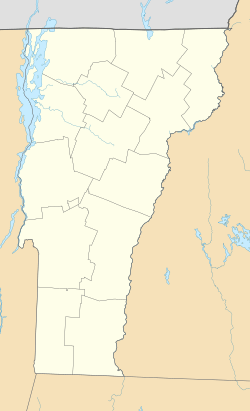Waterville Village Historic District facts for kids
Quick facts for kids |
|
|
Waterville Village Historic District
|
|
 |
|
| Location | VT 109, Oakes Rd., Church St., Griffin Rd., Fox Hill Rd., Beals Hill Rd., Lapland Rd., Waterville, Vermont |
|---|---|
| Area | 47 acres (19 ha) |
| Built | 1835 |
| Architectural style | Greek Revival, Colonial Revival |
| NRHP reference No. | 07001026 |
| Added to NRHP | September 28, 2007 |
The Waterville Village Historic District is a special area in Waterville, Vermont. It shows what a small village looked like in the 1800s and early 1900s. This district was once a busy center for people living in the countryside. It had shops, homes, and places for the community to gather. In 2007, this historic area was added to the National Register of Historic Places. This means it is a very important place to protect and remember.
Contents
Exploring Waterville Village's Past
How Waterville Village Began
The town of Waterville is in northern Vermont. People first settled here in the late 1700s. The town officially became a town in 1824. The village center grew along the North Branch Lamoille River. It was a "mill village," meaning it had many mills. The first mills were for cutting wood and grinding grain. These were built in the early 1800s. By the middle of the century, Waterville was a center for processing hemp. A factory for making flannel cloth started in 1846.
Changes Over Time
Not all businesses in Waterville lasted. Fires destroyed some of the successful factories. Later in the 1800s, the village's industries slowed down. This happened because local railroads did not come through Waterville. Eventually, all the old factory buildings were gone. They were either torn down or burned in fires. Today, the main business in the Waterville area is dairy farming.
What You See Today
The historic district is mostly around the main crossroads. This is where Main Street (Vermont Route 109) meets Church Street. Church Street was also called Bridge Street. This is because it leads to the covered bridge over the river. The district goes west along Bridge Street past the river. It also goes north on Main Street to another bridge. This bridge is a steel bridge built in the 1900s. The district also reaches south to Oakes Road.
Important Buildings and Homes
The main shop in the district is at the crossroads. Three buildings there now make up one large general store. On the east side of the crossroads is the town hall. This building used to be a Universalist church. It was built in the mid-1800s in the Greek Revival style. There are two other church buildings in the village. One was built in 1911 for a new Nazarene church group. Most of the homes in the district are simple and small. They are usually 1-1/2 stories tall. They are also made of wood.



